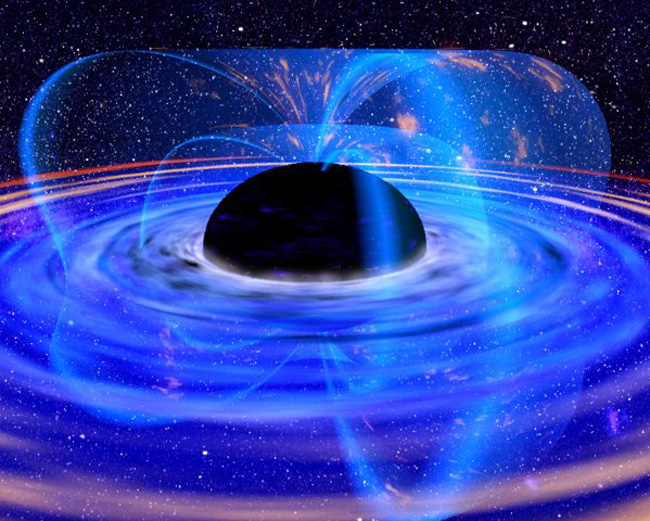Universe's Most Powerful Explosions Can Leave Black Hole Graves

When certain stars collapse, they release overwhelmingblasts of energy called gamma-ray bursts ? the most powerful explosion in theuniverse. But the cosmic leftovers of these violent outbursts have been amystery ? until now.
Two new studies suggest that when gamma-raybursts explode, some can leave behind black holes like cosmic gravestones, whileothers may end up as spinning neutron stars.
Gamma-ray bursts occur when some massive stars reach theends of their lives and exhaust their supplies of fuel for nuclear fusion intheir cores. Without the pressure from fusion pushing outward, gravity wins.
In the ensuing dramatic collapse, a flood of high-energy,short-wavelength gamma-ray light is released. They are sometimes associatedwith supernovas ? another explosiveway stars die ? but are separate events.
Bursts for black holes
One of the new studies found that for a certain class of thebrightest, most powerful gamma-ray bursts, only black holes will do.
"We have focused only on the brightest and most extremeGRBs, arguing that the energy release from these events is too large to bepowered by collapse to a neutron star (magnetar)," said study member BradCenko, a post-doctoral fellow from the University of California, Berkeley.
Breaking space news, the latest updates on rocket launches, skywatching events and more!
Magnetars are a type of neutronstar ? an object so dense its protons and electrons have merged toform neutrons. They are fast-spinning stars with extremely powerful magneticfields.
Neutron stars are restricted in how massive they can be ? ifthey weigh over a certain limit, then gravity would have collapsed the objectfurther into a black hole. Black holes, on the other hand, have no upper masslimit, so can encompass any mass needed to power a gamma-ray burst.
This team used data from NASA'sFermi spacecraft, which also observes in gamma-ray light.
The two studies, both presented Wednesday at the Gamma RayBursts 2010 conference in Annapolis, Md., help clarify the story behind some ofthe universe's most violent events. The scientists said their findings don'tconflict with each other.
"Our results are certainly not mutually exclusive - weboth are looking at relatively small sub-samples of GRBs," Cenko told SPACE.com.
Spinning star scenario
Another group of scientists studied a sampling of gamma-raybursts observed by NASA's Swift gamma-ray satellite.
They found that 11 of the gamma-ray bursts bore particularsignatures in the pattern of light they emitted that suggested a magnetarwas present.
On top of that weirdness, magnetars have the added quirk ofpossessing extremely strong magnetic fields. And these city-sized stars arealso spinning so fast they make a complete revolution within milliseconds.
Some researchers had thought magnetars wouldn't be massiveenough to produce the kind of energy required for a gamma-ray burst. But thenew study suggests that at least some are.
"I think what our work shows is that magnetars are aviable model," said Paul O'Brien of the U.K.'s University of Leicester, amember of the research team. "For this feature that we see, it's very hardto see how you could do it for a black hole. It's much more consistent with amagnetar model."
- Top 10 Greatest Explosions Ever
- Video ? Huge Explosion Up Close
- Top 10 Star Mysteries
Join our Space Forums to keep talking space on the latest missions, night sky and more! And if you have a news tip, correction or comment, let us know at: community@space.com.

Clara Moskowitz is a science and space writer who joined the Space.com team in 2008 and served as Assistant Managing Editor from 2011 to 2013. Clara has a bachelor's degree in astronomy and physics from Wesleyan University, and a graduate certificate in science writing from the University of California, Santa Cruz. She covers everything from astronomy to human spaceflight and once aced a NASTAR suborbital spaceflight training program for space missions. Clara is currently Associate Editor of Scientific American. To see her latest project is, follow Clara on Twitter.
